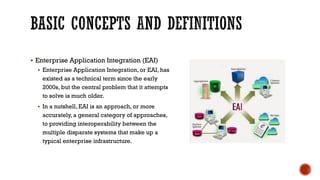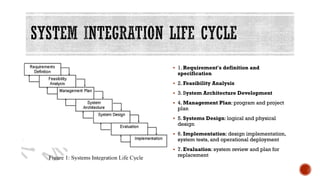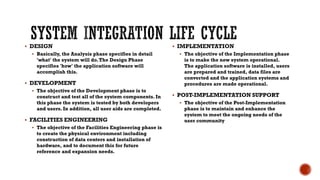Chapter 1 - Introduction to System Integration and Architecture.pdf
- 1. System Integration and Architecture
- 2. 1. Describe the fundamental aspects of system integration and architecture. 2. Determine problem solving of system integration in an organization. 3. Display managerial skills in planning system integration within a specific application domain.
- 3. Basic Concepts and Definitions System Architecture Model System Integration Life Cycle System Architecture as a Profession
- 4. System Integration Systems integration means that you allow a heterogeneous Information System (IS) to communicate or integrate and share information (or data) seamlessly with one another
- 5. Enterprise Application Integration (EAI) Enterprise Application Integration, or EAI, has existed as a technical term since the early 2000s, but the central problem that it attempts to solve is much older. In a nutshell, EAI is an approach, or more accurately, a general category of approaches, to providing interoperability between the multiple disparate systems that make up a typical enterprise infrastructure.
- 6. Enterprise architectures Enterprise architectures, by their nature, tend to consist of many systems and applications, which provide the various services the company relies upon to conduct their day to day business.
- 7. Silos are basically compartmentalized operating units isolated from their environment. Functional Silos Functional silos in a business are teams of employees, grouped by function, that all operate separately from each other, without cross-collaboration. Horizontal Silos Classification of organizations into departments like Accounting and Human Resources, reflects the breaking of complex tasks into smaller manageable tasks that could be assigned to a group of people who could then be held responsible. Vertical Silos Organizations also divided roles in hierarchical layers from strategic planning to management control and operation control
- 8. Vertical integration (as opposed to "horizontal integration") is the process of integrating subsystems according to their functionality by creating functional entities also referred to as silos Star integration also known as spaghetti integration, is a process of systems integration where each system is interconnected to each of the remaining subsystems. When observed from the perspective of the subsystem which is being integrated, the connections are reminiscent of a star, but when the overall diagram of the system is presented, the connections look like spaghetti, hence the name of this method. Horizontal integration Enterprise Service Bus (ESB) is an integration method in which a specialized subsystem is dedicated to communication between other subsystems. This allows cutting the number of connections (interfaces) to only one per subsystem which will connect directly to the ESB. A common data format is an integration method to avoid every adapter having to convert data to/from every other applications' formats, Enterprise application integration (EAI) systems usually stipulate an application- independent (or common) data format
- 9. Information Systems in Organizations Information Systems are a critical component of a successful organization today. Information Systems play a major role in primary and secondary activities of an organization’s value chain. The evolution of IS suggests that its role has generally been to support evolving information needs of the organization. Information Systems provide a high level of computer automation to support business functions such as: Accounting, Finance, Marketing, Customer Service, Human Resource Management, Operations, Manufacturing Supporting horizontal silos of organization Information systems provide analytical and decision making support for management, which is generally categorized into three levels- Strategic, Middle, and Operational. Supporting vertical silos of organization
- 10. A system architecture or systems architecture is the conceptual model that defines the structure, behavior, and more views of a system.An architecture description is a formal description and representation of a system, organized in a way that supports reasoning about the structures and behaviors of the system. A system architecture can consist of system components and the sub- systems developed, that will work together to implement the overall system. There have been efforts to formalize languages to describe system architecture, collectively these are called Architecture Description Languages (ADLs).
- 11. 1. Requirement's definition and specification 2. Feasibility Analysis 3. System Architecture Development 4. Management Plan: program and project plan 5. Systems Design: logical and physical design 6. Implementation: design implementation, system tests, and operational deployment 7. Evaluation: system review and plan for replacement
- 12. SYSTEMS PLANNING The objective of the Systems Planning phase is to develop the long-range systems plan for the implementation of an integrated, automated environment within an organization. PROJECT INITIATION Project Initiation is the first phase in undertaking any of the systems projects identified in the Long-Range Systems Plan. Its objective is to lay a proper foundation for the project, by establishing the relationship between the systems project and the Long- Range Systems Plan, by identifying key project personnel, and by establishing that there is adequate funding and commitment. ARCHITECTURE DEFINITION The objective of the Architecture Definition phase is to confirm and refine the high-level conceptual solution identified during the systems planning phase into an optimum solution to the problem, in the context of the environment, requirements and financial resources available. ANALYSIS The objective of the Analysis phase is to specify the proposed solution in detail. This involves further refining the requirements from the Architecture Definition phase.
- 13. DESIGN Basically, the Analysis phase specifies in detail 'what' the system will do.The Design Phase specifies 'how' the application software will accomplish this. DEVELOPMENT The objective of the Development phase is to construct and test all of the system components. In this phase the system is tested by both developers and users. In addition, all user aids are completed. FACILITIES ENGINEERING The objective of the Facilities Engineering phase is to create the physical environment including construction of data centers and installation of hardware, and to document this for future reference and expansion needs. IMPLEMENTATION The objective of the Implementation phase is to make the new system operational. The application software is installed, users are prepared and trained, data files are converted and the application systems and procedures are made operational. POST-IMPLEMENTATION SUPPORT The objective of the Post-Implementation phase is to maintain and enhance the system to meet the ongoing needs of the user community
- 14. Systems architects are computer professionals, who design, implement, and maintain databases and complex computer systems.They plan projects and activities, solve architectural issues, and maximize quality and efficiency throughout the network or system. Systems architects might work long hours to address database issues without interrupting a company's workday. Degree Level Bachelor's degree Experience Computer science or software engineering Licensure and Certification Voluntary; the Information Technology Infrastructure Library (ITIL) or Project Management Professional (PMP) certification is preferred Key Skills Customer service skills; excellent speaking and writing skills; experience with Microsoft Windows and Server software, Linux,TCP/IP and relevant software applications Salary* $106,430 per year (median salary for systems architects in 2016) https://study.com/articles/Become_a_Systems_Architect_Step-by-Step_Career_Guide.html














